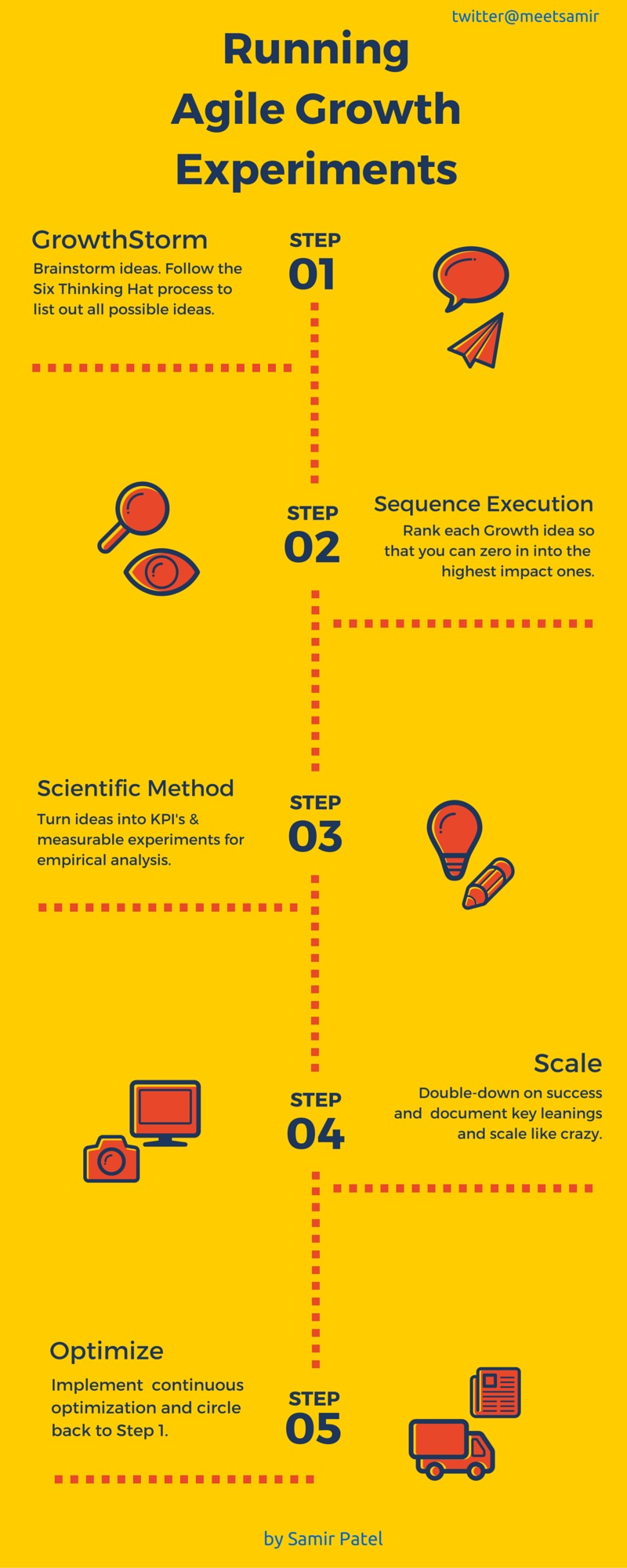After driving growth for the world’s largest companies, building automated trading systems like SearchForce and managing over $1 billion media spend while studying high growth companies like AirBnB, Uber and Zenefits, I’ve consolidated my experience into a single, strategic framework for building and running successful experiments for marketing.
Every organization is unique; each with different customers, markets, products, and business models. What is universal, however, is the opportunity for any business to adopt a highly scientific approach to marketing. Therefore, running lean and adopting a data-driven mindset to achieve breakthrough growth is not just a do or die for lean and mean startups — it’s for any organization that wants to build its own growth machine.
Marketing experiments involve five fundamental steps:
1. GrowthStorm
You start by brainstorming all sorts of ways to drive growth. You also generate ideas on how you can test these hypotheses. Put them in a process document called “GrowthStorm.” This will serve as a central creative repository for your growth efforts.
Download the template for experiments pipeline and growth storming here.
2. Prioritize execution
Once you have your collection of ideas, it’s time to organize them. Create a “Prioritize Execution” document that keeps tabs on past, current, and future experiments. This document should also include goals and projections for tests you’re running.
The doc provides a quick and easy way for team members to understand what tests have been run, when they were run, and their respective outcomes. Note: This document must be available at every level of the company, from the CEO on down to the implementation team. Running experiments in a silo makes it unlikely that insights will drive real action, particularly where skills across departments are required.
3. Apply the scientific method
Each test gets its own “Method” document stating, in detail:
- Problem: What is the test attempting to solve for
- Hypothesis: The specific results you expect to see
- Resource Estimation: The resources of time and energy you’ll need from your team
- Experiment: The nitty-gritty – implementation, elements, etc.
- Gather Data: Compiling test data once completed
- Action Items: Taking action on findings – optimizations and future test planning
Download the template for OKR Growth goal and a sample Method document.
4. Standardize learnings and scale
Once a test has been created, run, and analyzed, capitalize on your new insights by standardizing key findings back into your product and marketing.
The idea is that as you run more tests and gain more data and insights, you then use those data and insights to run smarter tests with more informed predictions. The growth process is cyclical, so the standardization phase isn’t the end of the process. Rather, it’s an ongoing process of up-leveling by which teams are constantly gaining greater insight into their customers and markets, and translating those insights into better user experience, better products, and more effective marketing.
Download the template for sample agile meetings and monthly tracking against goals.
Remember to learn from your tests.
The last step to this process is one of coming together as a team and taking the time to discuss questions, findings, ideas, and proposed actions related to the tests you’ve performed. This is a crucial part of the process because it’s easy to get so caught up in the implementation and management of current tests that the actual results of completed tests are overlooked.
5. Ask your growth team these key questions
-
What are we learning from the tests we’re running? (Just collecting the data isn’t enough.)
-
How can we double down on what’s working by refining successful tests? (When something works, focus on figuring out why.)
-
How do we implement our findings at scale? (Once you understand the why, how will you bring that learning to other areas of the business?)
-
What are we learning about what NOT to do? Not all tests will be successful and it’s crucial to take action on failed experiments.
-
What is the plan of action going forward? (Keep the heat on your team to maintain their testing schedule and continue to generate insights!)
Find out about VentureBeat’s upcoming agile marketing roadshow.
This is a process of focusing on specific tactical actions aimed at improving performance, and then stepping back for a more macro look at what’s working and what isn’t, and how to take action on key findings.
For example, from a 10,000-foot level you are learning to improve your product, UX, functionality, marketing, pricing, etc. This data will teach you how to optimize every one of your channels individually, and also which is most useful to choose from among those channels. You can monitor competitors’ data and use that for bench marking your progress.
Then you dive back in and actually plan and run new tests, and improve on current tests. You never stop toggling between these two vantage points; constantly communicating, collaborating, learning, and improving. This is your process to achieve hockey stick Growth via Agile.
References: Tammy Camp @ 500 Startups & The Scientific Method: How to Design & Track Viral Growth Experiments by Brian Balfour, Hubspot.
Samir Patel is president and CEO of Growth Machines and a growth mentor at 500Startups. You can follow him on Twitter: @meetsamir.
VentureBeat's mission is to be a digital town square for technical decision-makers to gain knowledge about transformative enterprise technology and transact. Learn More


